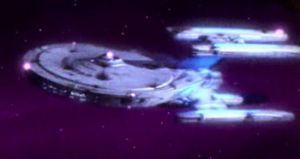Constellation class
From Trekipedia

Constellation class[1]
| Date Entered Service | 2275[3] |
| Number constructed | 126 |
| Length | 310m |
| Width | 140m |
| Height | 94m |
| Mass | 208,743mt |
| Cargo capacity | 12,500mt |
| Computer Type | M-6A |
| Transporters (Personnel) | 4 |
| Transporters (Emergency) | 4 |
| Transporters (Cargo, large) | 1 |
| Transporters (Cargo, small) | 2 |
| Crew | 350 |
| Passengers | 20 |
| Shuttlecraft | 8 |
| Cruising speed | Warp 12[2] (OCU)[4] |
| Warp 6[5] (MCU)[4] | |
| Emergency speed | Warp 14[2] (OCU)[4] |
| Warp 9[1] (MCU)[4] | |
| Weapons | 6 FH-14 Phasers in 3 banks |
| 4 torpedo tubes; Photon torpedoes |
The Constellation class was a starship type with four warp nacelles,[1] first commissioned circa 2275.[3] The warp nacelles and several components of the saucer section shared many design similarities with the Constitution and Miranda class designs of the era.[1] Constellation class ships were on the verge of being phased out in the mid-2360s,[6] but some were still in service in 2370.[7] Several had already been decommissioned by 2365, including the U.S.S. Hathaway NCC-2593, which had been stripped of its offensive systems and rendered "warp inactive" by removing all antimatter from its warp reaction system.[6]
Constellation class vessels
- U.S.S. Andromeda NCC-2505
- U.S.S. Antares NCC-2514
- U.S.S. Antietam
- U.S.S. Aquarius NCC-2517
- U.S.S. Betelgeuse NCC-2520
- U.S.S. Callisto NCC-2509
- U.S.S. Canopus NCC-2523
- U.S.S. Ceres NCC-2513
- U.S.S. Cochise
- U.S.S. Constellation NCC-1974
- U.S.S. Diadem NCC-2521
- U.S.S. Effros NCC-2519
- U.S.S. Eridani NCC-2511
- U.S.S. Fading Sun
- U.S.S. Ferrel
- U.S.S. Gettysburg NCC-3890
- U.S.S. Gibraltar
- U.S.S. Gihlan NCC-9761
- U.S.S. Hathaway NCC-2593
- U.S.S. Indiri NCC-2518
- U.S.S. Leonid NCC-2516
- U.S.S. Libra NCC-2506
- U.S.S. Magellan NCC-2504
- U.S.S. Magellan NCC-3069
- U.S.S. Minora NCC-2525
- U.S.S. Nebula NCC-2502
- U.S.S. Nova NCC-2501
- U.S.S. Orion NCC-2510
- U.S.S. Pisces NCC-2515
- U.S.S. Polaris NCC-2503
- U.S.S. Pulsar NCC-2508
- U.S.S. Sagittarius NCC-2507
- U.S.S. Sempach
- U.S.S. Sirius Major NCC-2524
- U.S.S. Speedwell
- U.S.S. Stargazer NCC-2893
- U.S.S. Taurus NCC-2512
- U.S.S. Tubman NCC-1757-B
- U.S.S. Valkyrie NCC-2590
- U.S.S. Vespucci
- U.S.S. Victory NCC-9754
References
- ↑ 1.0 1.1 1.2 1.3 "The Battle." Star Trek: The Next Generation, Episode 110. Television. 16 November 1987.
- ↑ 2.0 2.1 2.2 "Star Trek: The Next Generation Officers Manual." Star Trek: The Roleplaying Game, Supplement 2012. Game. 1988. FASA.
- ↑ 3.0 3.1 "Rihannsu, Book Four: Honor Blade." Star Trek, Book 96. Novel. October 2000. Pocket Books.
- ↑ 4.0 4.1 4.2 4.3 "Starships." Star Trek Roleplaying Game, Book 4. Game. 2003. Decipher, Inc.
- ↑ "Star Trek: The Next Generation Year One Sourcebook." Star Trek: The Roleplaying Game, Supplement 2227. Game. 1989. FASA.
- ↑ 6.0 6.1 "Peak Performance." Star Trek: The Next Generation, Episode 147. Television. 10 July 1989.
- ↑ "The Abandoned." Star Trek: Deep Space Nine, Episode 452. Television. 31 October 1994.